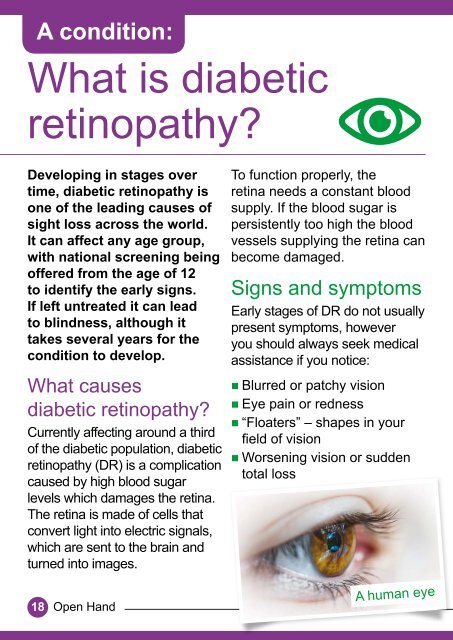Open Hand from Deafblind UK - Spring 2019 LoRes
Create successful ePaper yourself
Turn your PDF publications into a flip-book with our unique Google optimized e-Paper software.
A condition:<br />
What is diabetic<br />
retinopathy?<br />
Developing in stages over<br />
time, diabetic retinopathy is<br />
one of the leading causes of<br />
sight loss across the world.<br />
It can affect any age group,<br />
with national screening being<br />
offered <strong>from</strong> the age of 12<br />
to identify the early signs.<br />
If left untreated it can lead<br />
to blindness, although it<br />
takes several years for the<br />
condition to develop.<br />
What causes<br />
diabetic retinopathy?<br />
Currently affecting around a third<br />
of the diabetic population, diabetic<br />
retinopathy (DR) is a complication<br />
caused by high blood sugar<br />
levels which damages the retina.<br />
The retina is made of cells that<br />
convert light into electric signals,<br />
which are sent to the brain and<br />
turned into images.<br />
To function properly, the<br />
retina needs a constant blood<br />
supply. If the blood sugar is<br />
persistently too high the blood<br />
vessels supplying the retina can<br />
become damaged.<br />
Signs and symptoms<br />
Early stages of DR do not usually<br />
present symptoms, however<br />
you should always seek medical<br />
assistance if you notice:<br />
• nBlurred or patchy vision<br />
• nEye pain or redness<br />
• n“Floaters” – shapes in your<br />
field of vision<br />
• nWorsening vision or sudden<br />
total loss<br />
A human eye<br />
Over time a persistently<br />
high blood sugar level<br />
can damage these blood<br />
vessels. This happens in<br />
three stages:<br />
1 There are small<br />
changes in the eye but<br />
sight is not affected and<br />
treatment is not needed.<br />
There is an increased<br />
risk of future sight loss.<br />
2 There are greater<br />
changes to the eye<br />
including retinal bleeds.<br />
Sight is affected and<br />
diabetic screenings<br />
should increase to every<br />
3-6 months.<br />
3 There are significant<br />
changes in the eye,<br />
bleeds and retinal<br />
detachment. There is<br />
significant sight loss<br />
and treatment can<br />
stabilise but cannot<br />
improve your sight.<br />
Treatment<br />
and prevention<br />
The risk of developing DR can<br />
be reduced by controlling your<br />
blood sugar, blood pressure<br />
and cholesterol levels alongside<br />
taking all prescribed diabetic<br />
medications and living a<br />
generally healthy lifestyle.<br />
(Your GP can give advice about<br />
a healthy lifestyle). Also, ensure<br />
you attend your yearly diabetic<br />
eye screening appointment.<br />
Depending on the severity of<br />
the condition, laser treatments,<br />
eye injections or even eye<br />
surgery may treat DR.<br />
Having a sight test<br />
National charity Diabetes <strong>UK</strong> offers local support<br />
groups and advice lines, though you should always<br />
consult your GP for medical advice.<br />
18 <strong>Open</strong> <strong>Hand</strong><br />
<strong>Open</strong> <strong>Hand</strong> 19
















